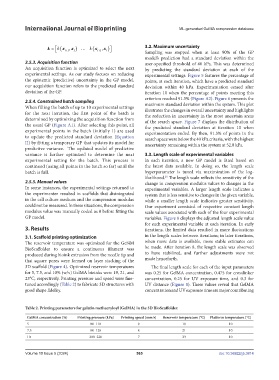Page 573 - IJB-10-5
P. 573
International Journal of Bioprinting ML-generated GelMA compression database
k
k x , x k x t 1 , x 3.2. Maximum uncertainty
t
1
t 1
Sampling was stopped when at least 90% of the GP
model’s prediction had a standard deviation within the
2.5.3. Acquisition function user-specified threshold of 40 kPa. This was determined
An acquisition function is optimized to select the next by predicting the standard deviation at each of the
experimental settings. As our study focuses on reducing experimental settings. Figure 5 features the percentage of
the epistemic (predictive) uncertainty in the GP model, points, at each iteration, which have a predicted standard
our acquisition function refers to the predicted standard deviation within 40 kPa. Experimentation ceased after
deviation of the GP. iteration 10 when the percentage of points meeting this
criterion reached 91.3% (Figure A2). Figure 6 presents the
2.5.4. Constrained batch sampling maximum standard deviation within the system. This plot
When filling the batch of up to 10 experimental settings illustrates the changes in overall uncertainty and highlights
for the next iteration, the first point of the batch is the reduction in uncertainty in the most uncertain areas
determined by optimizing the acquisition function from of the search space. Figure 7 displays the distribution of
the usual GP (Figure A1). After selecting this point, all the predicted standard deviation at iteration 10 when
experimental points in the batch (initially 1) are used experimentation ended. By then, 91.3% of points in the
to update the predicted standard deviation (Equation search space were below the 40 kPa criteria, with the highest
II) by fitting a temporary GP that updates its model for uncertainty remaining within the system at 52.8 kPa.
predictive variance. The updated model of predictive
variance is further optimized to determine the next 3.3. Length scale of experimental variables
experimental setting for the batch. This process is In each iteration, a new GP model is fitted based on
continued (using all points in the batch so far) until the the latest data available. In doing so, the length scale
batch is full. hyperparameter is tuned via maximization of the log-
likelihood. The length scale reflects the sensitivity of the
28
2.5.5. Manual values change in compression modulus values to changes in the
In some instances, the experimental settings returned to experimental variables. A larger length scale indicates a
the experimenter resulted in scaffolds that disintegrated system that is less sensitive to changes in the given variable,
in the cell culture medium and the compression modulus while a smaller length scale indicates greater sensitivity.
could not be measured. In these situations, the compression Our experiment consisted of respective constant length
modulus value was manually coded as 0 before fitting the scale values associated with each of the four experimental
GP model. variables. Figure 8 displays the adjusted length scale value
for each experimental variable at each iteration. In early
3. Results iterations, the limited data resulted in more fluctuations
3.1. Scaffold printing optimization in the length scales between iterations; in later iterations,
The reservoir temperature was optimized for the GeSiM when more data is available, more stable estimates can
BioScaffolder to ensure a continuous filament was be made. After iteration 8, the length scale was observed
produced during bioink extrusion from the needle tip and to have stabilized, and further adjustments were not
that square pores were formed on layer stacking of the made henceforth.
3D scaffold (Figure 4). Optimized reservoir temperatures The final length scale for each of the input parameters
for 5, 7.5, and 10% (w/v) GelMA bioinks were 19, 21, and was 0.25 for GelMA concentration, 0.475 for crosslinker
23°C, respectively. Printing pressure and speed were fine- concentration, 0.25 for UV exposure time, and 0.3 for
tuned accordingly (Table 2) to fabricate 3D structures with UV distance (Figure 8). These values reveal that GelMA
good shape fidelity. concentration and UV exposure time are major contributing
Table 2. Printing parameters for gelatin methacryloyl (GelMA) in the 3D BioScaffolder.
GelMA concentration (%) Printing pressure (kPa) Printing speed (mm/s) Reservoir temperature (°C) Platform temperature (°C)
5 80–110 9 19 10
7.5 90–120 8 21 10
10 200–220 7 23 10
Volume 10 Issue 5 (2024) 565 doi: 10.36922/ijb.3814

